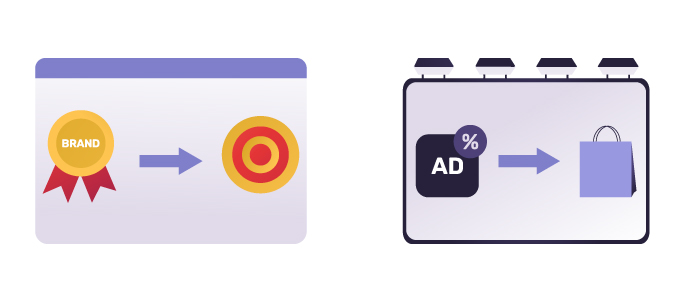Your Marketing vs. Advertising Guide to Boost Your Presence
Let’s be honest: when you hear marketing vs. advertising, you think they’re the same, right? This isn’t technically true, but it helps to imagine Batman and Robin being on the same team but with different roles. Although they each have unique talents, they become an unstoppable force together!
Moreover, whether you are an aspiring marketer, business owner, publisher, or advertiser, it always helps to know the differences, whether you plan on doing it yourself or knowing what to ask for.
Therefore, we are here to guide you and discuss some of the most essential aspects of the longstanding confusion between marketing vs. advertising.
So, let’s get started!
Table of Contents
What is Marketing?

Modern businesses use a combination of marketing and advertising strategies to attract potential customers and close deals. Marketing is responsible for building brand awareness, reaching a wider audience, and generating buzz through creative techniques.
Its objective is to position the product in a way that appeals to the ideal buyer. Therefore, the journey begins by making the customer aware of the product and ends with converting them into loyal customers.
As such, marketing encompasses everything from understanding and predicting customer needs to navigating the complex market. It goes beyond just capturing the customer’s attention.
Moreover, it involves nurturing that attention through online and offline campaigns until the customer becomes a die-hard fanatic, and it is essential to provide top-notch support even after they have bought into your brand.
Whether you are in the B2C or B2B industry, marketing is all about knowing your audience, understanding their needs, and offering solutions on a silver platter.
It is about crafting a narrative that resonates with the customer, building relationships, and increasing revenue.
Marketing Key Components

Marketing has seven critical components through which the big companies are guiding:
- Product: What does your business offer?
- Price: How much does it cost?
- Place: Where can your business goods be found?
- Promotion: How do you spread the word regarding your business offerings?
- People: To whom does your business deliver the goods?
- Process: How it’s all done?
- Physical process: What tangible benefits does the customer receive?
Therefore, whether creating the perfect ad or refining your marketing strategy, remember that it is not just about making a sale but creating an experience that encourages customers to return.
Marketing Channels and Approaches
Marketing is about building lasting connections with your audience through various channels, such as social media, content, email, etc.
So, let’s explore each type of marketing channel and provide practical examples.
Social Media Marketing
Social media involves using platforms like Facebook, Instagram, TikTok, and Twitter to interact with your audience, promote your products, and track the effectiveness of your social media efforts.
Content Marketing
Content marketing involves crafting captivating content that resonates with your audience at each step of their buying journey, whether an eBook, webinar, or viral video.
Email Marketing
On the other hand, this approach lets you keep your customers informed about your latest offerings and spark meaningful conversations through newsletters and promotional campaigns using the good old email.
Search Engine Optimization Marketing
SEO helps you climb the ranks in search engines by optimizing your content for keywords your customers look for.
For example, if your business sells women’s shoes, you could optimize your website content so that when someone browses for women’s shoes, your business appears in the top results.
Indeed, it could be a long journey but a rewarding one.
Rewarding Mix of Paid, Owned and Earned Media
A business’s success depends on all three channels, and it involves a master to manage all skillfully.
- Paid media is paid advertising on platforms like Facebook, Twitter, and Instagram.
- Owned media refers to your channels, such as your business website or blog, depending on your niche.
- Earned media is unpaid visibility through user-generated content, or your content is shared on other channels.
Influencer Marketing
As the name says, it involves leveraging the reach and authenticity of famous social media personalities to promote your brand.
Affiliate Marketing
You can choose affiliate marketing to reward partners for successfully bringing in sales.
Inbound Marketing
Inbound focuses on creating content that grabs your customers’ attention and nurtures a connection, subtly inviting them to perform a specific call to action rather than bombarding them with ads.
Word-of-Mouth Marketing
It is probably the oldest form of marketing that relies on satisfied customers spreading the word about your brand.
Account-Based Marketing
ABM is a B2B marketing tactic used by sales teams to act on a targeted audience through tailored messages, nurtured connections, and answering your customer’s inquiries.
The more effective your ABM campaign is, the more qualified leads you will have.
Relationship Marketing
This strategy heavily relies on building customer trust and satisfaction and nurturing long-term relationships for better retention.
Now, let’s discover what advertising is all about and whether this is for you.
What is Advertising?

Advertising is a powerful and essential tool for businesses to promote their offerings and, thus, drive sales. It is a strategic art that amplifies and sustains your marketing goals through DOOH commercials, native ads, social media ads, search ads, YouTube ads, and CTV ads.
Through ingenious campaigns and compelling slogans, the advertising sector catches immediate actions like purchases, leads, and subscriptions while fostering brand awareness and loyalty. However, it’s important to recognize fallacies in advertising, which can sometimes mislead consumers and impact trust.
Investing in your brand’s visibility establishes your presence and motivates customers to engage while nurturing and growing your lead pipelines. Thus, you pave the way for growth and enduring success.
Types of Advertising

Let’s examine the various types of advertising techniques. First, it is essential to know that there are two main categories: traditional and digital advertising.
Traditional Advertising
This refers to conventional advertising methods, like newspaper ads, broadcast advertising, physical emails, out-of-home Advertising (OOH), radio spots, and print advertising.
These methods have been around for decades and are still widely used today, especially when they can efficiently reach your target audience if they aren’t tech-savvy.
Digital Advertising
Digital advertising is a newer form of marketing that uses the Internet to reach potential customers. It has become increasingly popular as more people spend time online.
Here are some common types of digital advertising: Search Engine Advertising (SEA), social media advertising, display advertising, email marketing (automation), mobile advertising, and more.
Marketing vs. Advertising: 7 Key Differences

Alright, let’s discuss the differences between marketing and advertising. Marketing involves creating a strategy to captivate your audience and build brand loyalty.
At the same time, advertising focuses on grabbing attention through various channels, such as TV, newspapers, and social media, to drive immediate action.
Here are seven key differences between marketing and advertising:
1. Responsibilities
Marketing teams manage various tasks, including branding and competitor analysis, to keep their brands ahead of the curve. In contrast, advertising teams work on customer analysis and creative production to make their message heard loud and clear.
2. Scope
Marketing encompasses everything from product development to customer relationships, while advertising is focused on getting your message out there.
3. Goals
Marketing aims for long-term success by building brand loyalty and expanding market share. At the same time, advertising focuses on driving short-term results, such as sales or promoting a specific offer.
4. Timeframe
Marketing strategies unfold over time, gradually building brand awareness and customer loyalty. Conversely, advertising campaigns are designed to grab attention and stimulate action quickly.
5. Approach
Marketing takes a holistic view of the customer’s journey, focusing on long-term engagement and satisfaction. Advertising uses persuasive messaging to influence behavior and drive immediate action.
6. Audience
Marketing reaches out to a broad audience and builds lasting relationships with customers, while advertising aims to capture the attention of a specific audience and drive them to act.
7. Purpose
Marketing shapes perceptions and builds lasting connections with your audience, while advertising generates buzz around your brand and drives immediate action.
Finding the perfect balance between marketing vs. advertising is vital, whether crafting a marketing strategy to build long-term relationships or launching an advertising campaign to drive immediate sales.
Marketing vs. Advertising: Similarities

A successful marketing strategy relies not only on advertising, as an advertising campaign can only succeed with a strong marketing foundation.
Although both marketing and advertising aim to promote products and services, they follow different paths.
Marketing does the preliminary work, which includes research, strategy, and product development. It is the strategist behind the scenes, identifying potential customers, analyzing the competition, and shaping the brand’s identity to make it stand out.
However, advertising is the showstopper that grabs attention and spreads the word through different types of ads, from billboards to social media feeds.
However, here is the twist: advertising is just a single piece of the marketing puzzle, amplifying the brand’s message and reaching a broader audience.
Think of marketing as the architect who sketches the blueprint for success, while advertising is the spotlight that illuminates the brand for everyone to see. Together, they form a dynamic duo that drives customer engagement and opens doors to new opportunities.
Marketing vs. Advertising: How To Develop Effective Campaigns

For a campaign to succeed, it is essential to comprehend your target audience and establish precise objectives for each discipline involved. Though seemingly similar, marketing and advertising each bring their unique strengths.
Marketing campaigns typically have a broad reach and focus on raising awareness without delving too deeply into the product specifics. Their goal is to reach as many people as possible.
On the other hand, advertising is more personal and tailored to specific niche demographics, with customized messaging and visuals.
Ads should be concise and straightforward, while marketing can adopt a more relaxed approach with long-form storytelling. Once the target audience and competitors have been identified, it is time to craft a comprehensive plan.
A solid marketing strategy maps out the entire customer journey, ensuring that ads are present at every critical stage. Unlike advertising, designed for quick hits and short-term campaigns, marketing focuses on long-term brand loyalty and building a solid narrative that resonates with consumers over time.
In essence, marketing is the big-picture strategist, overseeing various activities to meet business objectives. It is all about playing the long game and creating a compelling story that consumers will remember.
Conversely, advertising is more of a sprinter, racing towards immediate results and quick wins through short-lived campaigns to drive sign-ups or event attendance.
When to Integrate Advertising into Your Marketing Strategy

Mixing and matching marketing tactics is the key to success. Although digital channels offer precise targeting, where does advertising fit this equation?
Here is what you need to know:
- Define Your Objectives: Determine your targets, whether you want to create brand awareness or drive direct sales. Your objectives will shape your advertising strategy.
- Utilize Marketing Insights: Understand your audience’s preferences and online habits to personalize your approach.
- Allocate Your Budget Wisely: Allocate your advertising budget across different platforms strategically for maximum impact.
- Stay Consistent: Maintain a consistent brand tone and values in your ad messaging.
- Know Your Audience Inside Out: Understand your audience’s world to create ads that resonate personally.
- Prioritize Compelling Content: Content is king! Ensure your content speaks to your audience, whether in blogs or videos.
- Customize Ads Based on Insights: Use data from your marketing efforts to craft ads that hit the target every time.
- Engage and Learn: Interact with your audience to gather valuable insights and build relationships.
- Track and Adjust: Regularly monitor the performance of your strategies and adjust them to optimize results.
- Stay Ahead of Trends: Keep up with digital trends and tools to maintain a competitive edge.
- Keep Learning: Attend workshops and courses to improve your skills and advance your strategies.
Marketing vs. Advertising: Common Mistakes to Avoid

Mistakes are common in both advertising and marketing. These mistakes include needing to understand your audience, disregarding feedback, setting vague objectives, mishandling budgets, and neglecting to adapt to changing trends.
For example, if you do not understand your target audience, it can result in low engagement and poor conversion rates. Therefore, conducting thorough research on your audience, including their demographics, preferences, and motivations, is essential to tailor your campaigns effectively.
Another mistake is ignoring your competition. Analyzing competitors’ strategies can provide valuable insights and help you develop innovative campaign ideas.
It is important to note that copying the competition is not advisable, but understanding their tactics can help you stand out in the marketplace.
Failing to track campaign metrics is akin to driving blindfolded. You need to monitor Key Performance Indicators, leads, and user engagement to save resources with a clear direction for improvement. To ensure the success of your marketing endeavors, you should utilize marketing analytics tools, such as Google Analytics.
Remember, every campaign has room for improvement, but you need data to guide your decisions and ensure effectiveness.
Final Thoughts
Marketing vs. advertising are often used interchangeably, but they serve distinct purposes. Advertising involves timely and strategic brand communication, while marketing takes a broader and long-term approach to optimize promotional efforts.
Think of marketing and advertising as the perfect sandwich combo. Each is tasty, but when combined, they create something unforgettable. Continuously tweak your strategies to resonate with your audience and drive business growth.
No matter your company’s size, marketing and advertising are crucial for attracting customers and seizing new opportunities. Do not let budget constraints hold you back.